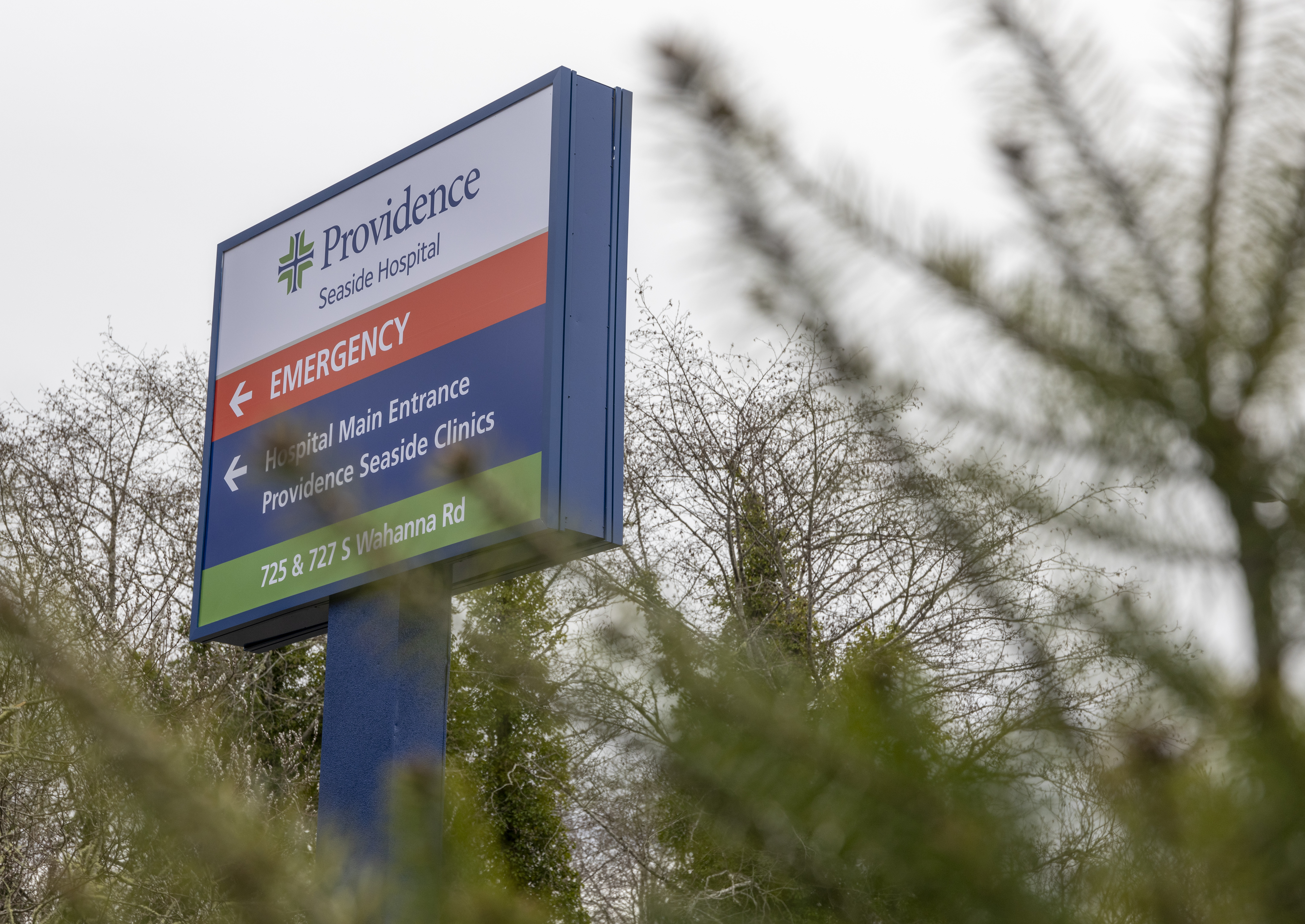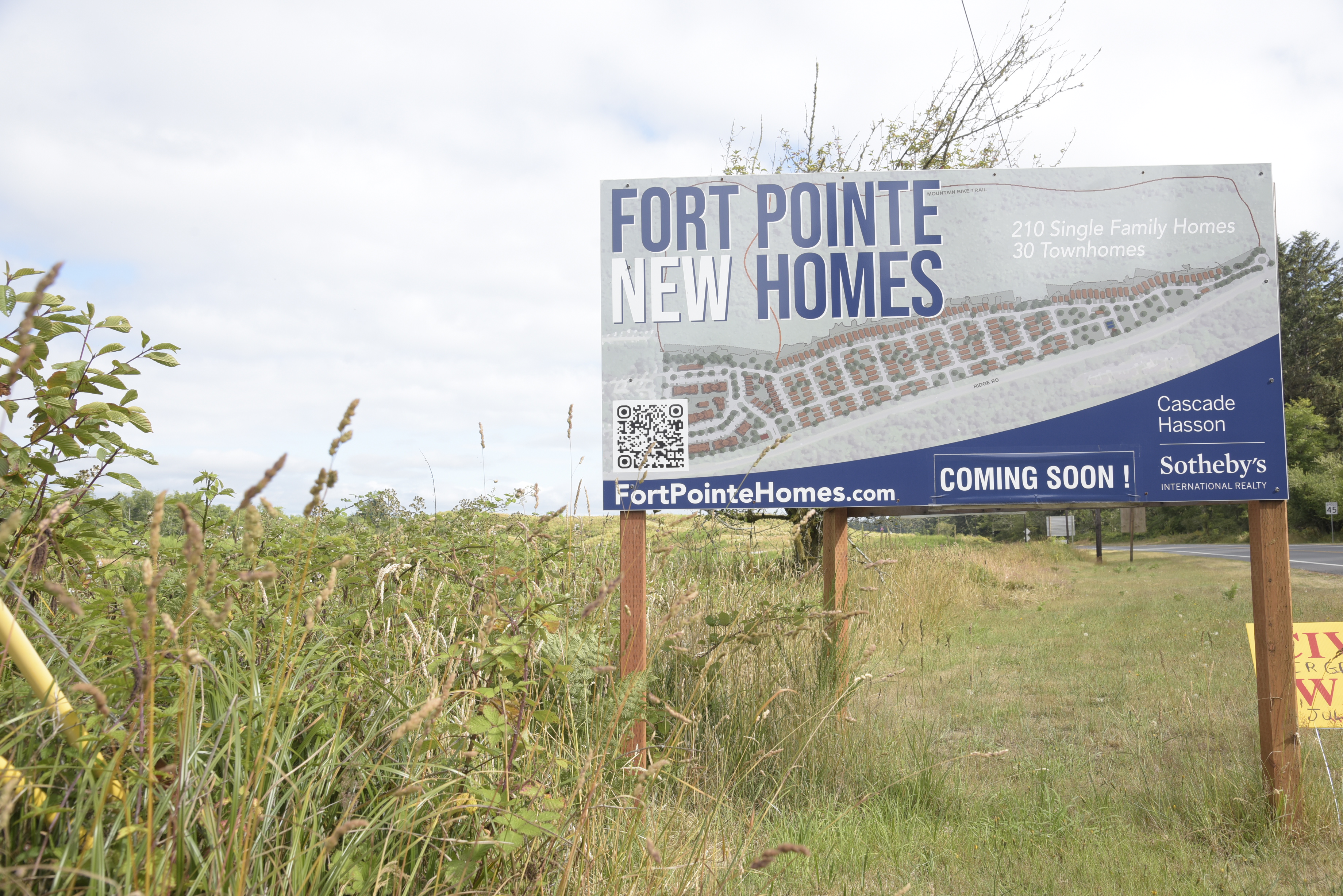Astoria searches for balance on hotels
Published 1:45 pm Friday, September 6, 2019

- The Holiday Inn Express & Suites sits just off the Columbia River beneath the Astoria Bridge.
An Astoria mayor once celebrated a new Hilton-brand hotel by breaking ground with a gold shovel.
Trending
“It’s hard to build on the river and not block someone’s view,” Mayor Willis Van Dusen said at the ceremony for the Hampton Inn & Suites at 39th Street in 2011.
Gesturing to the forested hillside across Lief Erikson Drive, he added, “There isn’t a view to block. This is perfect.”
With 87 rooms, the hotel would be the city’s largest at the time and the third major hotel brand to front the Columbia River.
Trending
Does Astoria need more hotels? The Astorian looked behind the politics and asked experts in the travel and tourism industry for answers.
Let us know what you think in a letter to the editor: bit.ly/2kuT0PZ
Eight years later, while debating code amendments for future development along the riverfront on the opposite side of town, Mayor Bruce Jones asked city staff to investigate a ban on corporate chain hotels and restaurants within city limits.
The idea, supported by the City Council, arrived after more than a year of back and forth around a single question: Does Astoria need more hotels?
The discussions dancing around the question have played out in election campaigns, community petitions and public hearings. They have shaped debate about the role of tourism and how Astoria should — or should not — grow.
Market forces
Astoria has 14 active hotel businesses with just under 750 rooms, according to city records.
Last year, two hotel applications went before the city: a controversial 66-room Marriott-brand hotel, the Fairfield Inn and Suites, developed by Bellingham-based Hollander Hospitality; and a 39-room boutique hotel from the developers behind Buoy Beer Co. and the Adrift Hotel on Washington state’s Long Beach Peninsula.
Plans for a third hotel, a 90-plus room Marriott or Hilton franchise on Youngs Bay, have not progressed since news of the potential project first broke, but hotel development on the site remains a possibility.
This summer, several hotels came under new ownership. The Holiday Inn Express & Suites next to the Astoria Bridge sold to an Idaho-based company. Following the death last year of its developer, Robert “Jake” Jacob, the boutique Cannery Pier Hotel was sold to a Vancouver, Washington, hospitality group. Another of Jacob’s former hotels, the Atomic Motel, was sold to Mark Frank.
To Dean Runyan, the president of Dean Runyan Associates, which has documented the economic significance of the tourism industry for Travel Oregon, the market has spoken.
“That’s your answer as it were,” he said. “Do you have enough? And the market is saying, ‘No.’
“The initiative to build a hotel is largely a private sector initiative,” he explained. “The public sector can encourage it and foster it in different ways and sometimes they directly subsidize it. That can happen. But really it is private investors who decide when and where and how to build lodging.”
Caroline Wuebben, the general manager for the Holiday Inn Express, takes a different view.
“I think we have the right balance,” she said, speaking in her role as chairwoman of the Lower Columbia Tourism Committee. “More hotels mean more people during the busy peak season and I’m not sure we want to have that.”
She is hesitant to make such observations, knowing how it sounds given her job at Holiday Inn.
“I’m not opposed to competition,” she said. “I just think from a community standpoint, we are at a good place.”
Occupancy rates
Occupancy rates are high during the spring and summer months and many in the tourism industry have shifted resources to drumming up business during the shoulder seasons.
Clatsop County as a whole has 50 hotel properties with 2,683 rooms, according to data provided to Travel Oregon by STR, which tracks industry trends. In June, those rooms were at a 74.1% occupancy rate. For the year to date through June, the occupancy rate was 56.1%.
Lenders that fund hotel development view a market as “effectively full” when occupancy rates are consistently at 75%, said Andy Olsen, vice president with Columbia Hospitality and the former chairman of the Washington Lodging Association.
“It’s very difficult to sell out 100%,” he said.
Lodging has seen a slight leveling in recent years despite an increase in dollars spent on travel, as recorded in a recent study by Dean Runyan Associates. There are concerns across a variety of sectors, including the hospitality and travel industries, about a coming recession. Wuebben hasn’t seen this slowdown reflected in new hotel applications. In fact, she only hears of more inquiries and proposals.
Astoria clearly remains attractive to developers.
But, she cautioned, “I think that pie is getting divided up into smaller chunks for everybody.”
Dismay
When Hollander Hospitality proposed the four-story Fairfield Inn and Suites off the river at the base of Second Street, there was an immediate outcry from a vocal and active segment of the city’s population. They dissected the hotel’s boxy, generic design and worried about the impact of such a large building on views and public access.
Did Astoria really need another large hotel? Especially right on the riverfront? What did it mean for future development?
Similar dismay met the announcement of the possible 90-plus room Hilton or Marriott project on the South Slope on land where hotels are an outright use.
By the time of a debate between mayoral candidates last fall, Hollander’s project had already been rejected by two different city boards and had an appeal filed with the City Council.
Jones, a city councilor at the time, was running for mayor, but as city councilor, he would be a supporting vote in upholding Hollander’s appeal for the Fairfield Inn. He agreed with the majority of the council that city codes did not support denying the developer’s plea.
But he was ready to question the proposed South Slope development.
“I don’t think we need a 90-room hotel on the South Slope,” Jones said during the debate. “I think we need 90 apartments on the South Slope.”
Hearings on the Fairfield Inn coincided with discussions about the Urban Core, the final, downtown section of the city’s Riverfront Vision Plan. The plan guides development along the river. But the process of vetting the Fairfield Inn revealed ambiguities and gaps in another section of the plan — Bridge Vista in Uniontown — jump-starting further review of riverfront codes.
What began as straight-forward clarifications morphed into something much larger as elected officials and people in the community saw a chance to address broader concerns about how large-scale development along the river might alter the character of Astoria.
The height and scale of new buildings in Bridge Vista, which stretches from Portway Street to Second Street, were suddenly up for another debate.
On Tuesday, that debate came to a partial close. The City Council decided on a 28-foot height limit for new buildings in Bridge Vista, or 35 feet if the developer grants public access. The size of a building would be limited to 30,000 square feet and can only occupy half of a lot’s area with a view corridor to the river.
That same night, Jones also proposed an investigation into limiting chain hotels and restaurants. During his bid for mayor and during the Hollander appeals hearing, he had suggested if hotels are the problem, change the zoning so the use is not allowed outright.
In an interview the week before, the mayor had wondered if residents most interested in restricting development and building heights along the river were primarily opposed to hotels.
“You dig a little deeper and you ask why and they say what they really don’t want is any more chain hotels. So then you have to ask what’s more important for the city to address: a prohibition on hotels period, or limiting chain hotels.”
City Councilor Roger Rocka, a former director of the Astoria-Warrenton Area Chamber of Commerce, had pushed for a 28-foot-height limit in Bridge Vista and has preferred this approach as a tool to limit uses along the river.
“Do we need more hotels? I don’t know,” Rocka said. “But there may become a point where we do. Do we need them on the riverfront is the question I struggle with.”
Years before, Rocka had been part of the push to develop the Astoria Riverwalk and preserve views and public access. In the early 2000s, he and others fought against a slew of potential condominium projects. If they thought their work was done, the Fairfield Inn was a wake-up call, he said.
Local owners
Yet a third waterfront hotel project that emerged last year did not encounter any of the anxiety or furor that met the Fairfield Inn or South Slope projects.
Proposed by the developers behind Buoy Beer and the Adrift Hotel, the 39-room boutique hotel tentatively named the Bowline involves repurposing a former seafood processing plant on the Riverwalk next door to the brewery at the base of Ninth Street.
Since receiving approval from the Planning Commission in January, the developers have started pulling permits with the city. They anticipate beginning major construction at the end of the month and hope to have the hotel open by next summer.
“I am prejudiced toward local owners who are already invested in the community, who have proven themselves to provide good businesses,” City Councilor Joan Herman said.
Herman has been a vocal advocate of development restrictions along the riverfront. She approved of the Bowline’s smaller scale and the fact it would repurpose an existing building.
Like those who testified at public hearings about the Bridge Vista code amendments, Herman emphasized the need to preserve the waterfront for future generations and not allow it to be built out with hotels like other communities that rely heavily on tourism.
Similar to the Bowline, few people have had concerns about a hotel like the Cannery Pier. In fact, Jacob’s hotel was referenced often as a sort of gold standard during debates over the design and appearance of the Fairfield Inn.
But a number of the corporate hotels are owned or at least managed by local people, Jones noted. If the concern is local versus corporate, a purely local project on the scale of the Cannery Pier Hotel will not happen often, he said.
“I don’t know how you would have gotten more people like Jake Jacob to step up,” Jones said. “It’s one thing to say you don’t want corporate businesses in town, but it’s very, very difficult for local people to get that kind of financing.”
So far, neither Hollander’s Fairfield Inn project nor the South Slope development have moved forward. Hollander won the appeal but has yet to pull any permits with the city. The developer has just over a year to take advantage of the city’s approval. Hollander also owns vacant property just to the west of the Maritime Memorial Park and the Astoria Bridge.
Astoria Hotel Investors, a partnership between Kansas City, Missouri, developers John Ferguson and Lew Wiens, still owns the South Slope property. The site, complete with the decaying remains of the former Bayside Sentry Market, remains as untouched as ever and city staff have not heard from the developers about permits.
If all of these hotel proposals and other short-term lodging projects — such as a development that includes a mix of long-term apartments and vacation rentals the city recently approved near Safeway — actually come on board, “that’s a pretty substantial increase,” Jones said.
“If those projects all were to open, then you’re probably reasonably at a point where you can say we have enough,” the mayor added. “You don’t want any one leg of your economy to be dominant because then you will be weak if that sector takes a hit.”
The role of tourism
Hotel development often happens in waves. As new hotels come on the market, opportunities will change. Room rates and occupancy will likely dip for a while after a new hotel arrives and scoops up a share of visitors.
Hotels are visible markers of the region’s increasing economic reliance on tourism, and something — along with big-box stores — that some Astorians now point to as symbols of what they don’t want in their city.
But tourism was a $12 billion industry in Oregon last year, and the coast is a powerhouse. The region ranked second in overnight visits, just behind the Willamette Valley. The North Coast especially has reaped the benefits — and experienced the drawbacks.
More than just hotels benefit from booming business. Tourist dollars fuel local shops and restaurants, employ huge numbers of seasonal and year-round workers and help industries not directly connected to visitors: farming, landscaping, construction, electrical and plumbing.
In recent years, the lodging taxes Astoria collects — from in-home Airbnb-type offerings to hotels and motels — have climbed from $1.3 million in the 2013-14 fiscal year to $2.1 million in 2017-18. Following an increase to the tax and the settlement of a lawsuit against the Astoria Riverwalk Inn, the city has collected $2.8 million for the 2018-19 fiscal year.
“Having a number of guests — tourists — come into the community every year provides an economic shot in the arm,” Herman said, “but there are two sides to it.”
Elected officials like Herman, Rocka and Jones have concerns beyond the number of visitors. There is a lack of lower-priced, workforce housing and some employers have struggled to find seasonal workers because of the shortage.
“If we’re building more hotels, where are the employees going to live?” Herman asked.
Across cities on the coast, there are questions about the impacts of tourism on traffic, city infrastructure, wildlife, hiking trails and locals’ quality of life.
“When is enough enough, right?” Marcus Hinz, the executive director of the Oregon Coast Visitors Association, said. “And I think depending on who you are you’re going to have different answers for that.”
He has heard from many coastal residents who feel that what they see right now is enough — if not too much. The newly formed North Coast Tourism Management Network, a project led by Travel Oregon, exists solely to look at ways to make tourism more sustainable, both environmentally and economically.
Almost more useful than asking a question like, “Does Astoria need more hotels?” is to prod at other criteria, Hinz thinks.
“Will this enhance the overall quality of life for residents and will we be able to maintain a quality of experience for visitors?”
“And that last question causes you to look around, ‘Well, we could build another hotel, but there’s not more seats in the restaurants and there’s not more spaces in the parking lot and there’s already too many people on the trails,’” he said. “So the quality of experience for the visitors will decline.”









